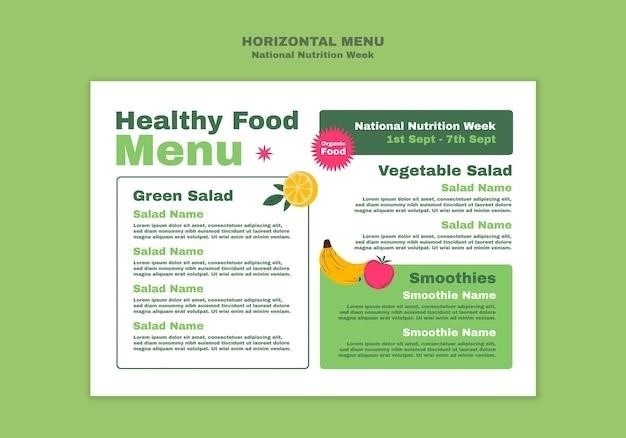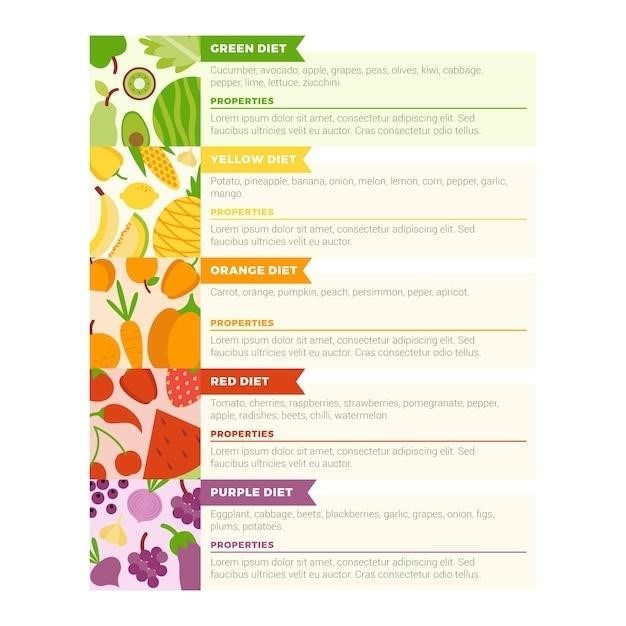
Dieta Antiinflamatoria⁚ A Guide to Reducing Inflammation Through Food
An anti-inflammatory diet is a dietary approach designed to reduce chronic inflammation in the body. It focuses on consuming foods that possess anti-inflammatory properties while limiting those that may exacerbate inflammation. This dietary approach can be beneficial for individuals seeking to improve overall health, manage chronic conditions, and promote well-being.
What is an Anti-Inflammatory Diet?
An anti-inflammatory diet is a dietary approach that aims to reduce chronic inflammation in the body by focusing on consuming foods with anti-inflammatory properties and limiting those that may exacerbate inflammation. This approach is gaining popularity due to its potential benefits for overall health, managing chronic conditions, and promoting well-being.
Chronic inflammation is a low-grade, persistent inflammation that occurs in the body over a prolonged period. While acute inflammation is a necessary response to injury or infection, chronic inflammation can contribute to various health issues, including heart disease, diabetes, arthritis, and some types of cancer.
An anti-inflammatory diet emphasizes consuming foods rich in antioxidants, omega-3 fatty acids, and fiber, while limiting processed foods, saturated fats, sugar, and refined carbohydrates. This dietary approach focuses on incorporating whole, unprocessed foods like fruits, vegetables, lean proteins, and healthy fats into the diet.
By reducing chronic inflammation, an anti-inflammatory diet can help improve various aspects of health, including reducing pain and stiffness, improving cardiovascular health, boosting the immune system, and promoting healthy aging.
Benefits of an Anti-Inflammatory Diet
An anti-inflammatory diet offers a range of potential benefits for overall health and well-being. By reducing chronic inflammation, this dietary approach can contribute to improved cardiovascular health, enhanced immune function, pain management, and even potential protection against certain chronic diseases.
One of the significant benefits of an anti-inflammatory diet is its potential to improve cardiovascular health. Reducing inflammation in blood vessels can help lower the risk of heart disease, stroke, and other cardiovascular complications. By promoting healthy blood flow and reducing plaque buildup, this diet can contribute to a healthier heart.
Moreover, an anti-inflammatory diet can play a crucial role in boosting the immune system. By reducing chronic inflammation, the body can better fight off infections and diseases. This dietary approach can also help manage autoimmune conditions, which are characterized by an overactive immune system that attacks the body’s own tissues.
For individuals experiencing chronic pain, particularly those with arthritis, an anti-inflammatory diet can offer relief. By reducing inflammation in joints and tissues, this diet can help alleviate pain, stiffness, and improve mobility.
Furthermore, an anti-inflammatory diet may contribute to a reduced risk of developing certain chronic diseases. While more research is needed, studies suggest that this dietary approach may help prevent or manage conditions like diabetes, cancer, and neurodegenerative diseases.
Foods to Include in an Anti-Inflammatory Diet
An anti-inflammatory diet emphasizes the consumption of foods rich in antioxidants, fiber, healthy fats, and phytonutrients. These foods possess anti-inflammatory properties that can help combat chronic inflammation in the body.
Fruits and vegetables are essential components of an anti-inflammatory diet. They are packed with antioxidants, which help neutralize harmful free radicals that contribute to inflammation. Berries, such as blueberries, strawberries, and raspberries, are particularly rich in antioxidants. Other fruits, including oranges, apples, and pears, also offer valuable anti-inflammatory benefits.
Leafy green vegetables, such as spinach, kale, and collard greens, are excellent sources of vitamins, minerals, and antioxidants. Cruciferous vegetables, including broccoli, cauliflower, and Brussels sprouts, contain compounds that have been shown to have anti-inflammatory effects.
Fatty fish, such as salmon, tuna, and mackerel, are rich in omega-3 fatty acids, which have potent anti-inflammatory properties. These fatty acids can help reduce inflammation in the body, particularly in the heart, brain, and joints.
Nuts and seeds are also valuable additions to an anti-inflammatory diet. They are rich in healthy fats, fiber, and antioxidants. Almonds, walnuts, flax seeds, and chia seeds are excellent choices.
Other foods to include in an anti-inflammatory diet include olive oil, garlic, ginger, turmeric, and green tea. These foods contain compounds that have been shown to have anti-inflammatory effects.
Foods to Avoid in an Anti-Inflammatory Diet
While an anti-inflammatory diet emphasizes the inclusion of anti-inflammatory foods, it also involves limiting or avoiding those that may exacerbate inflammation. These foods often contain inflammatory compounds, added sugars, unhealthy fats, and processed ingredients that can contribute to chronic inflammation.
Processed foods, including packaged snacks, fast food, and pre-made meals, are often high in unhealthy fats, added sugars, and sodium. These ingredients can promote inflammation in the body, leading to various health issues.
Refined grains, such as white bread, white rice, and pasta, are low in fiber and nutrients. They can cause blood sugar spikes, leading to increased inflammation. Opting for whole grains, such as brown rice, quinoa, and whole-wheat bread, is a healthier alternative.
Added sugars, found in sugary drinks, desserts, and processed foods, can contribute to inflammation. These sugars promote insulin resistance, which can lead to chronic inflammation and various health problems.
Trans fats, found in processed foods and some fried foods, are highly inflammatory. They can increase bad cholesterol levels and decrease good cholesterol levels, contributing to heart disease and other inflammatory conditions.
Alcohol consumption can also increase inflammation in the body. It can damage the liver, increase gut permeability, and contribute to various health issues.
By limiting or avoiding these inflammatory foods, individuals can significantly reduce inflammation and improve their overall health.
Sample Anti-Inflammatory Diet Menu
This sample menu provides a glimpse into a typical day of an anti-inflammatory diet, highlighting the emphasis on whole, unprocessed foods and nutrient-rich ingredients. It is important to note that this is just a sample menu, and individual needs and preferences may vary. Consulting with a registered dietitian or healthcare professional can help personalize a diet plan that aligns with individual goals and health conditions.
Breakfast⁚ Oatmeal with berries and walnuts. This breakfast option provides a good source of fiber, antioxidants, and healthy fats.
Lunch⁚ Salmon with roasted vegetables and quinoa. Salmon is rich in omega-3 fatty acids, which have potent anti-inflammatory properties. Roasted vegetables provide a variety of vitamins and minerals, while quinoa offers a complete protein source.
Dinner⁚ Lentil soup with whole-wheat bread. Lentil soup is a hearty and nutritious option, packed with fiber, protein, and antioxidants. Whole-wheat bread provides a source of fiber and complex carbohydrates.
Snacks⁚ A handful of almonds, a piece of fruit, or a small bowl of Greek yogurt with berries. These snacks provide a boost of energy and nutrients throughout the day.
This sample menu demonstrates the principles of an anti-inflammatory diet, emphasizing whole foods, healthy fats, and a variety of fruits, vegetables, and legumes. By incorporating these foods into your daily meals and snacks, you can promote a healthy inflammatory response and support overall well-being.
Tips for Following an Anti-Inflammatory Diet
Embarking on an anti-inflammatory diet can be a rewarding journey toward better health, but it requires a mindful approach and consistent effort. Here are some tips to help you navigate this dietary shift successfully⁚
Read food labels carefully⁚ Pay close attention to ingredient lists, particularly for added sugars, processed ingredients, and unhealthy fats. Opt for minimally processed foods and focus on whole, natural options.
Cook more meals at home⁚ This gives you control over ingredients and cooking methods, allowing you to prepare meals with fresh, wholesome ingredients. Experiment with new recipes and explore the diverse world of anti-inflammatory cuisine.
Plan ahead⁚ Take time to plan your meals and snacks for the week. This will help you make healthier choices and avoid impulsive decisions when hunger strikes.
Listen to your body⁚ Pay attention to how different foods make you feel. Some foods may trigger inflammation or digestive discomfort in certain individuals.
Don’t be afraid to experiment⁚ The beauty of an anti-inflammatory diet lies in its versatility. Explore new recipes, flavors, and cuisines that align with your preferences and dietary needs.
Be patient⁚ It takes time to adjust to a new dietary approach. Be patient with yourself and celebrate your progress along the way. Consistency and commitment are key to realizing the benefits of this dietary shift.
The Importance of Consistency
Consistency is the cornerstone of success when it comes to adopting an anti-inflammatory diet. Just as a single workout won’t transform your fitness, a single anti-inflammatory meal won’t magically cure chronic inflammation. It’s the sustained effort, the daily commitment to making healthier choices, that truly yields results.
Imagine your body as a garden. If you plant a few anti-inflammatory seeds here and there, but then neglect the garden, those seeds might struggle to sprout. But if you tend to the garden regularly, providing it with consistent nourishment and care, it will flourish.
Similarly, the benefits of an anti-inflammatory diet accrue over time. Consistent consumption of anti-inflammatory foods gradually reduces inflammation, improves gut health, strengthens the immune system, and contributes to overall well-being.
Don’t get discouraged if you slip up occasionally. The key is to get back on track as soon as possible. Instead of viewing setbacks as failures, see them as opportunities to learn and adjust your approach. Remember, consistency is not about perfection, but about progress.
By making a conscious effort to eat anti-inflammatory foods most of the time, you’re setting the stage for a healthier, happier you.
Resources for Further Information
The journey towards a healthier lifestyle often involves seeking out more information and support. Fortunately, there are a wealth of resources available to guide you on your anti-inflammatory diet path.
Start with reputable online sources like government health websites (e.g., the National Institutes of Health in the US) and respected medical organizations. These websites offer evidence-based information on nutrition, inflammation, and dietary recommendations.
Consider consulting with a registered dietitian or a nutritionist specializing in anti-inflammatory diets. They can provide personalized guidance, address your specific health concerns, and help you create a meal plan tailored to your needs and preferences.
Explore books and articles written by experts in the field of anti-inflammatory nutrition. Look for authors with a strong scientific background and a focus on practical, evidence-based advice.
Don’t underestimate the power of online communities. Join forums and social media groups dedicated to anti-inflammatory eating. These communities offer a platform for sharing experiences, recipes, and tips; You’ll find encouragement, support, and valuable insights from others on a similar journey.
Remember, knowledge is power when it comes to your health. Embrace the opportunity to learn and grow, and you’ll be well on your way to reaping the benefits of an anti-inflammatory diet.

Download Your Anti-Inflammatory Diet Menu PDF
Ready to embark on your journey towards a healthier, less inflamed you? We’ve got you covered! Download our comprehensive anti-inflammatory diet menu PDF, packed with delicious and easy-to-follow recipes and meal plans. This menu is designed to guide you through a week of anti-inflammatory eating, providing a balanced and flavorful approach to reducing inflammation in your body.
Our PDF menu offers a variety of options for breakfast, lunch, dinner, and snacks. From vibrant salads bursting with antioxidants to hearty protein-rich meals, you’ll discover a world of culinary possibilities that align with your anti-inflammatory goals. Each recipe includes detailed instructions and nutritional information, making it simple to plan and prepare your meals.
This PDF is more than just a menu; it’s a practical tool to help you navigate the world of anti-inflammatory eating. It’s a starting point for creating a healthy, sustainable lifestyle that nourishes your body from the inside out. So, click the download button and get ready to experience the power of food in reducing inflammation and promoting overall well-being.